Introduction
Have you ever noticed how lighting can completely change the atmosphere of a room? Whether it is a cozy living room or a functional kitchen, lighting plays a pivotal role in defining a space’s mood. Layering lighting is more than just a design technique; it is an art that ensures every corner of a room is well-lit and functional. In this guide, we will focus on using a layered lighting design with ceiling light and wall light combinations, offering practical tips to enhance the ambiance of any room.
What Is Layered Lighting?
Layered lighting is a strategic approach that involves using different types of lighting to create a balanced, versatile environment. Instead of relying on a single overhead light, layered lighting combines multiple sources to provide depth and dimension. This method not only adds functionality to the room but also enhances its visual appeal. By using ceiling light and floor lamp combinations, you can create a well-lit space that feels inviting and purposeful.
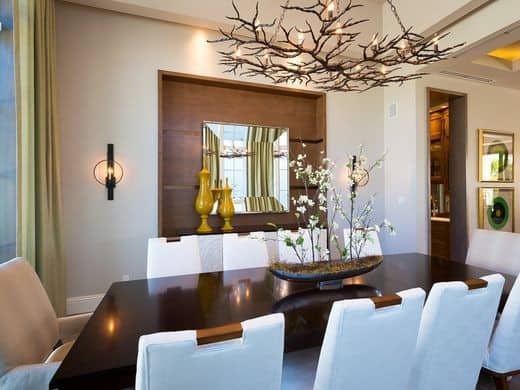
Image credit: Houzz / David Warfel
The Three Main Types of Lighting Layers
Layered lighting consists of three main types: ambient lighting, task lighting, and accent lighting. Each of these layers serves a distinct purpose, working together to provide comprehensive illumination.
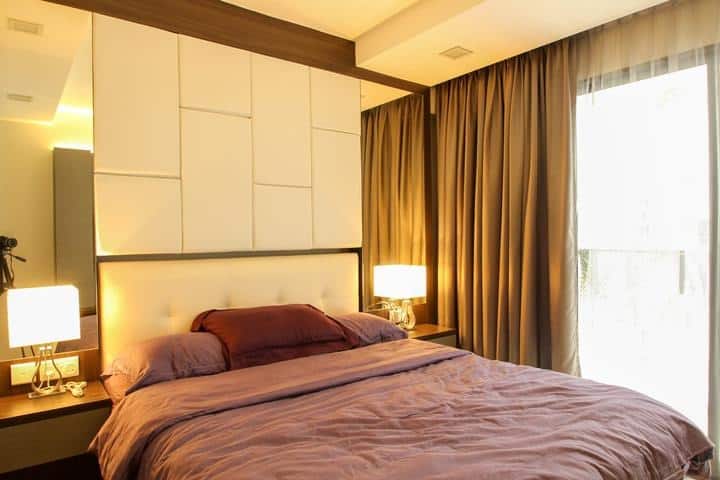
Image credit: Qanvast / Fifth Avenue Interior
Ambient Lighting
Ambient lighting is the foundation of any lighting plan, providing overall illumination to ensure visibility throughout the space. It sets the tone of the room, creating a base layer of light that is soft yet sufficient. Common types of ambient lighting include ceiling fixtures like chandeliers, flush mounts, and recessed lights. This type of lighting is ideal for living rooms, bedrooms, and other areas where general visibility is essential.
Task Lighting
Task lighting provides focused illumination for specific activities, like reading, cooking, or working. It is often brighter than ambient lighting to help prevent eye strain and increase productivity. Ceiling lights like adjustable track lights, pendant lights, or under-cabinet fixtures are commonly used as task lighting. Incorporating task lighting is crucial for areas like kitchens, home offices, and study nooks.
Accent Lighting
Accent lighting adds visual interest by highlighting specific features of a room, such as artworks, architectural elements, or decorative pieces. This type of lighting is typically softer and helps create depth, making the space feel more dynamic. Ceiling-mounted spotlights, track lighting, or cove lights are ideal choices for accent lighting. Accent lighting is often used in living rooms, hallways, or spaces where you want to draw attention to specific elements.
The Role of Ceiling Lights in Layered Lighting
Ceiling lights are essential for achieving a well-layered lighting design. They act as the primary source of light, providing both ambient and task lighting, and sometimes accent lighting. By using different types of ceiling fixtures, you can ensure that the room has a balanced light distribution. Whether you use chandeliers, recessed lights, or smart ceiling lights, these fixtures are versatile and adaptable to various lighting needs.
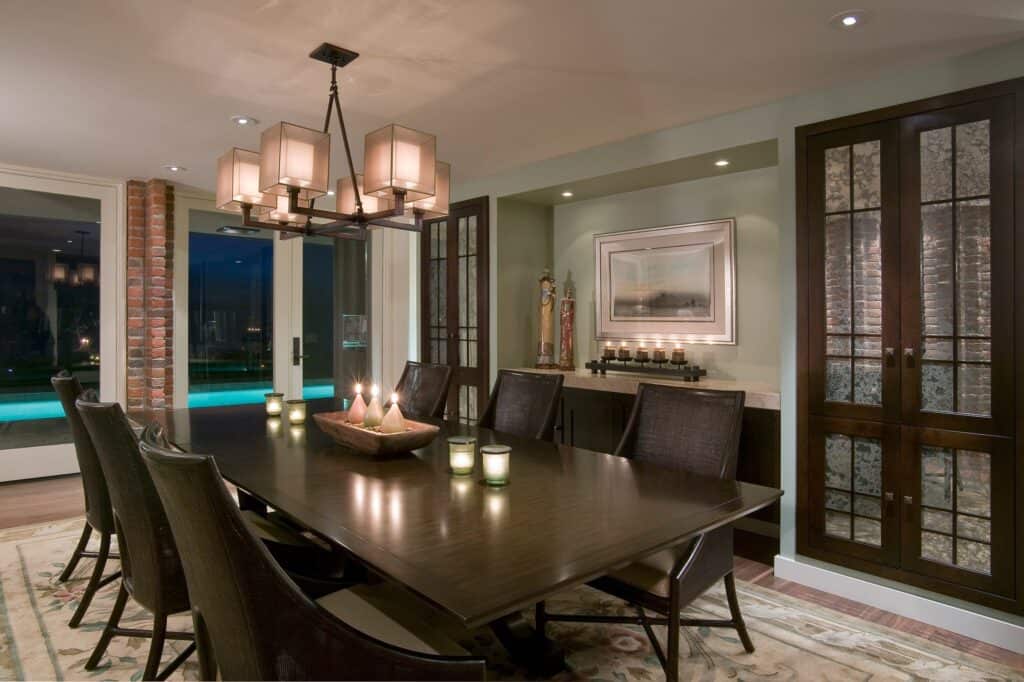
Image credit: Houzz / GDC Construction
Step-by-Step Guide to Layering Lighting with Ceiling Lights
To effectively layer lighting, follow these easy steps and adapt them to your room’s specific requirements.
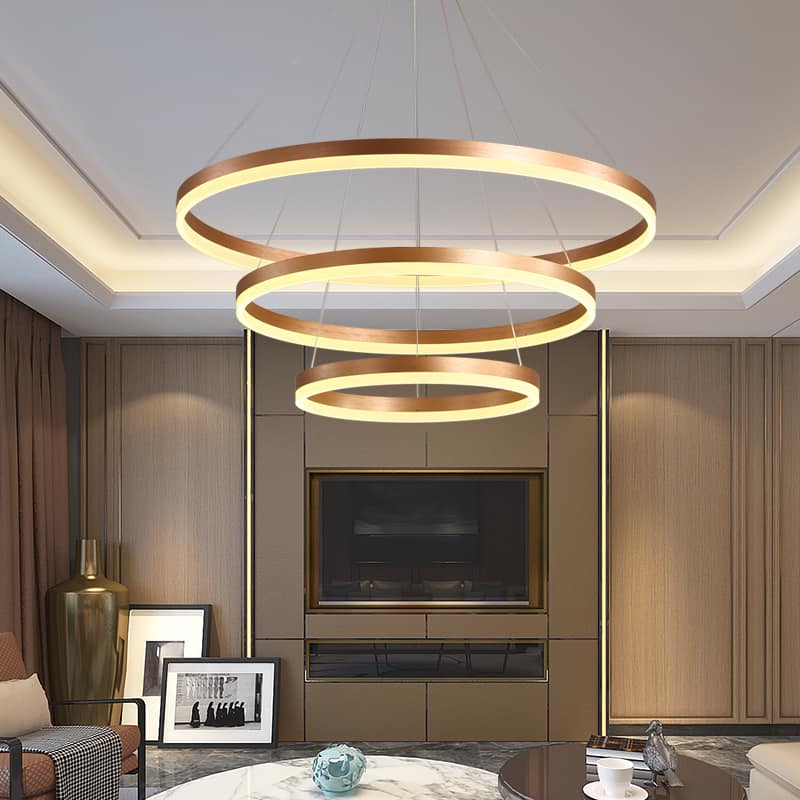
See this product: Labuana Ring Pendant Light
Step 1: Understand Your Space Needs
Before diving into the lighting plan, take a moment to analyze the room’s size, layout, and intended function. Is it a cozy living area that demands warm mood lighting, or is it a bright kitchen where clarity is essential? Understanding these needs helps in selecting the right ceiling lights that will enhance both the function and feel of the room.
Step 2: Start with Ambient Lighting
The first step in layering lighting is to establish ambient lighting. Begin by installing ceiling lights like flush mounts, chandeliers, or recessed lights. The goal here is to provide general illumination that covers the entire space. This creates a well-lit base layer that ensures comfort and visibility throughout the room.
Step 3: Add Task Lighting for Functionality
Once the ambient lighting is set, add task lighting to enhance functionality. Pendant lights over kitchen islands, adjustable track lights over a study desk, or recessed lights above a bathroom mirror are all good examples of ceiling-mounted task lighting. For more versatility, consider combining ceiling lights with table lamps, providing additional focused lighting as needed.
Step 4: Incorporate Accent Lighting for Depth
To add character and depth to the room, incorporate accent lighting. Use ceiling-mounted spotlights or cove lighting to highlight artwork, architectural elements, or decorative features. Accent lighting is not about overwhelming brightness; it is about creating a subtle focus that enhances the room’s visual interest and aesthetic appeal.
Different Types of Ceiling Lights for Layering
Choosing the right ceiling lights is essential for successful layered lighting. Each type offers a different form of illumination and serves a distinct purpose in the overall design.
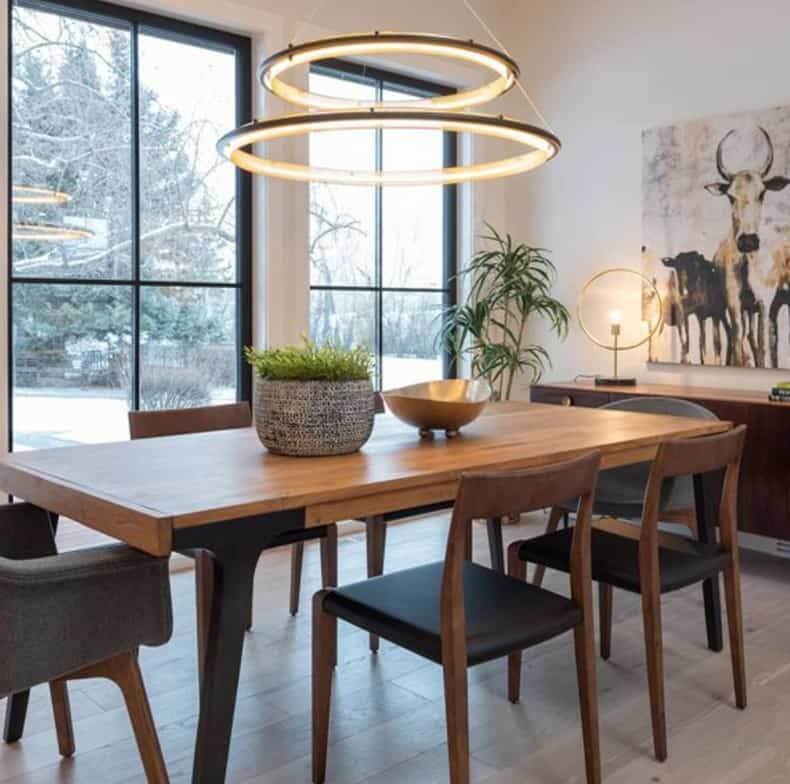
See this product: Lanuda Round Ring Grid Frame Pendant Light
Flush Mount Ceiling Lights
Flush mount ceiling lights are perfect for rooms with low ceilings, as they provide broad, even illumination without taking up much space. These fixtures are commonly used in living rooms, bedrooms, and hallways as the main source of ambient lighting.
Chandeliers and Pendant Lights
Chandeliers add a touch of elegance and serve as a focal point in rooms like dining areas or grand entryways. Pendant lights, on the other hand, are more versatile and can be used in kitchens, over dining tables, or in hallways. Both of these ceiling lights contribute to ambient and task lighting, depending on their placement.
Recessed Lighting
Recessed lighting, also known as can lighting, is a popular choice for modern interiors. It is discreet and blends seamlessly into the ceiling, providing a clean and uncluttered look. Recessed lights can be used for ambient, task, or accent lighting, making them highly adaptable.
Track Lighting
Track lighting is an excellent choice for adding versatility and flexibility to the lighting design. It consists of multiple light heads mounted on a single track, allowing you to adjust the direction of each light. This makes it suitable for both task and accent lighting.
Cove Lighting
Cove lighting involves placing LED strips or rope lights along the edges of a ceiling, creating an indirect, soft glow. It adds a sense of depth and is ideal for creating relaxed, mood lighting. Cove lighting is commonly used in living rooms, bedrooms, and other areas where a warm ambiance is desired.
Tips for Achieving the Right Balance of Light
Achieving a balanced lighting design involves mixing different types of ceiling lights to create layers of light that work together. Start with ambient lighting to provide general illumination, then add task lighting for specific needs, and finish with accent lighting to add visual interest. Consider incorporating dimmable ceiling lights to adjust the intensity of the lighting as needed.
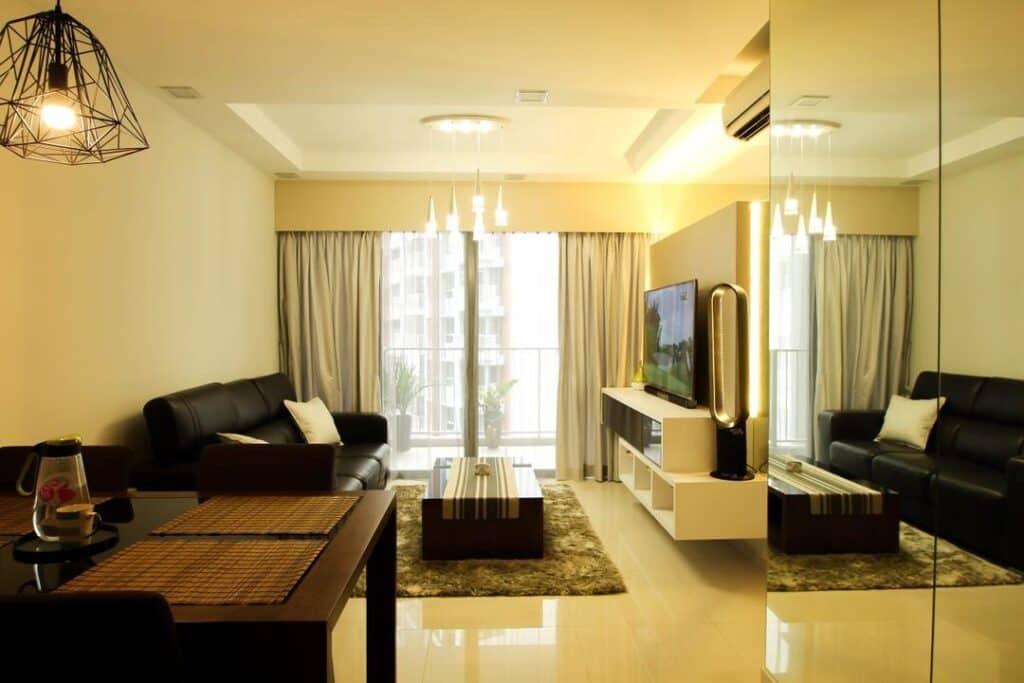
Image credit: Qanvast / Fifth Avenue Interior
Best Ceiling Light Placement for Layering
The placement of ceiling lights can significantly impact the overall lighting effect. Central ceiling lights should be positioned to provide even ambient lighting, while task lights should be placed over work areas like kitchen islands or desks. Accent lights should be directed toward artwork, architectural features, or other points of interest. Proper placement ensures that the room is well-lit without any dark corners.
Choosing the Right Bulbs for Your Ceiling Lights
Selecting the right bulbs is crucial for achieving the desired ambiance. Warm bulbs (2,700K to 3,000K) create a cozy, welcoming atmosphere, while cool bulbs (4,000K to 5,000K) are ideal for workspaces. The brightness level (measured in lumens) also matters, as it determines how well-lit the room will be. Use smart ceiling lights to adjust color temperature and intensity through a remote or mobile app for better control.
How to Use Dimmers for Better Control
Dimmers offer greater control over the intensity of the light, allowing you to adjust the brightness according to the room’s needs and mood. For example, dimming the lights in the living room during movie night creates a cozy ambiance, while brightening the kitchen during meal prep ensures better visibility. Dimmable ceiling lights are versatile and can be added to most ceiling light fixtures, making them a valuable part of any lighting design.
The Impact of Light Colors on Ambiance
The color temperature of light bulbs can influence the mood of a room. Warmer tones (2,700K to 3,000K) evoke feelings of comfort and relaxation, making them suitable for living rooms and bedrooms. Cooler tones (4,000K to 5,000K), on the other hand, promote focus and energy, making them ideal for kitchens and home offices. Combining ceiling light and table lamp setups can also enhance the mood, creating a seamless blend of different light sources.
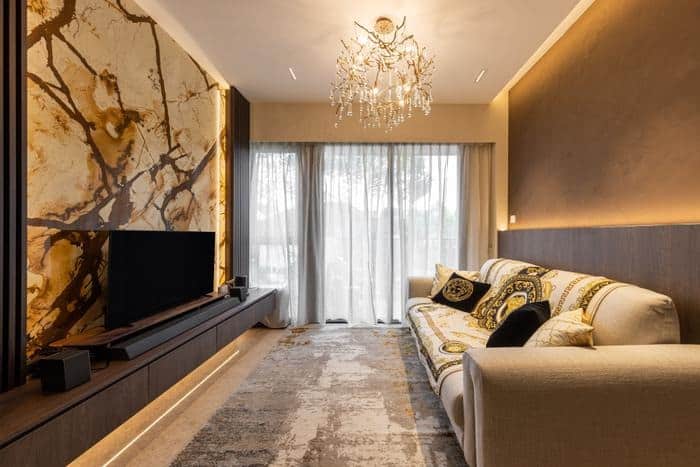
Image credit: Qanvast / Swiss Interior Design
Common Mistakes to Avoid When Layering Lighting
When layering lighting, avoid common mistakes such as over-lighting or under-lighting the space. Relying on only one type of ceiling light can lead to an unbalanced design, while mismatching light color temperatures can create an inconsistent ambiance. Ensure that each lighting layer works together to create a cohesive look that integrates ceiling light and wall light combinations effectively.
Advantages of Layering Lighting with Ceiling Lights
Layering lighting with ceiling lights provides numerous benefits, including improved ambiance, enhanced functionality, and added visual interest. It creates a versatile space that can adapt to various activities, from brightening up a workspace to creating cozy mood lighting for relaxation. With the right mix of ceiling light and floor lamp combinations, you can create a well-lit environment that is both functional and visually appealing.
Conclusion
Mastering the art of layered lighting with ceiling lights can transform any room into a functional and aesthetically pleasing space. By combining ambient lighting, task lighting, and accent lighting, you can achieve the optimal ambiance that suits your needs and style. Whether it is a cozy living room or a bright kitchen, layering lighting ensures that every corner is well-lit and inviting.
FAQs
- What is the best type of ceiling light for layering?
Recessed lights and track lighting are popular choices for layered lighting, as they can serve both ambient and task purposes. Pendant lights also offer flexibility and can contribute to both task and accent lighting. - Can I use only ceiling lights for layered lighting?
Yes, ceiling lights can effectively be used for all three layers of lighting—ambient, task, and accent. The key is to choose a variety of fixtures that fulfill different lighting needs. - What is the ideal color temperature for living room lighting?
Warm color temperatures (around 2,700K to 3,000K) work best for living rooms, as they create a cozy and inviting atmosphere. Cooler tones are better suited for workspaces. - Are dimmable ceiling lights necessary?
Dimmable ceiling lights offer more control over the ambiance and allow for flexibility, making them highly recommended for most spaces. - How many ceiling lights should I use in a room?
The number of ceiling lights depends on the room’s size and layout, but aim for a balanced mix of ambient, task, and accent lights to create a well-lit space.




